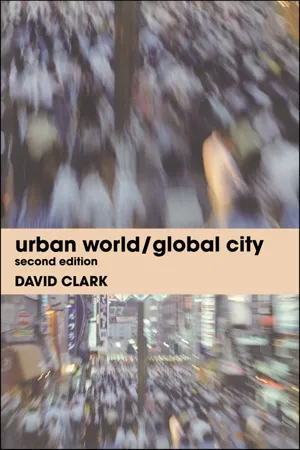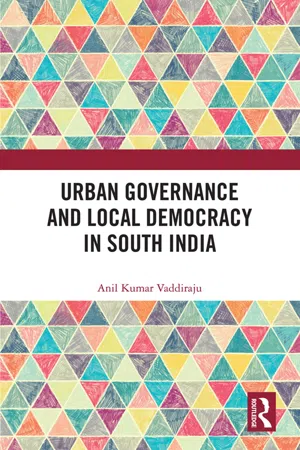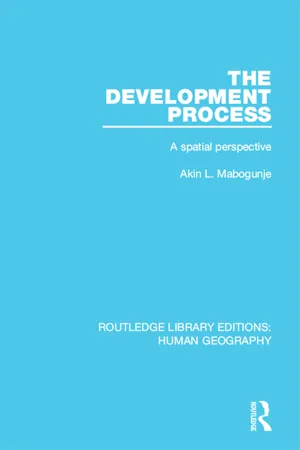Geography
Primate City
A primate city is the largest and most economically dominant city in a country, often overshadowing all other urban areas. It typically serves as the political, economic, and cultural center of the nation, exerting a disproportionate influence on the country's development and functioning. Primate cities can lead to regional imbalances and uneven distribution of resources and opportunities.
Written by Perlego with AI-assistance
Related key terms
Related key terms
1 of 4
Related key terms
1 of 3
4 Key excerpts on "Primate City"
- eBook - ePub
- David Clark(Author)
- 2004(Publication Date)
- Routledge(Publisher)
Differences in size are inevitably reflected in an imbalance of importance and role. Primate cities typically dominate their countries in economic and political terms. Invariably they are the centres in which national elites and other major decision makers and opinion leaders are concentrated. They are the headquarters for national television and telephone services and have the principal, indeed in many cases the only, international airport. In turn, they are the link points through which the dependent village population is connected to the global urban system.Studies of city size distributions provide an indirect insight into the characteristics of urban linkages and connectivity. Together with work on the distribution of the urban population, they paint a picture of gross unevenness and variable integration. Not only are the spread of urban population and the level of urban development far from uniform, but cities differ significantly in the extent and ways in which they interconnect and interdepend. Cities in countries with rank-size patterns tend to be well integrated within wider networks; those in countries with primate distributions, with the exception of the Primate City itself, are predominantly inward-looking and have strongest connections with the indigenous economy.These differences suggest that the global urban system is presently fragmented and incomplete. Rather than a coherent whole, the contemporary urban world consists of a set of loosely knit subsystems. The largest is global in extent and is based upon movements and exchanges of people, goods, images, information and ideas among rank-sized urban centres and primate cities. It is dominated by the cities in the core economies, but also includes the primate and principal centres in the periphery. Other subsystems, in the periphery, have primate cities as their apexes, but have few external links except through the Primate City and so function primarily at a local scale. Still others, in the most remote and backward parts of the periphery, are divorced even from national urban systems and so operate in comparative independence and isolation. Such observations provide support for those who question the idea of a global urban hierarchy and regard it as misleading and unhelpful. - eBook - ePub
Southeast Asia (Routledge Revivals)
A Region in Transition
- Jonathan Rigg(Author)
- 2013(Publication Date)
- Routledge(Publisher)
Sources: World Bank 1989, Lee-Jay Cho and Bauer 1987, p. 16, Ginsburg 1988, p. 41.Notes: 1) 1982 data. 2) Weighted relative to 1985/7 population and excluding Brunei.Urban primacy
The concept of the Primate City was first developed by Jefferson in a short paper published in 1939. With reference to London, Paris and a number of other cities he noted that they were both considerably larger than the second cities of their respective countries and were also functionally dominant:The finest wares are to be found there, the rarest articles, the greatest talents, the most skilled workers in every science and art. Thither flows an unending stream of the young and ambitious in search of fame and fortune, and there fame and fortune are found. London is the kingdom’s market for all that is superlative in intellectual and material productions. Its supereminence as a market runs parallel to its supereminence in size. It is the Primate City of the United Kingdom … All over the world it is the Law of the Capitals that the largest city shall be supereminent, and not merely in size, but in national influence (Jefferson 1939, pp. 226–7).Table 7.2The primate cities of Southeast AsiaNotes: 1) Source: Jones 1988, p. 139. 2) Source: World Bank 1987. 3) The ratio of the population of the largest city to that of the next three largest. Source: Jones 1988, p. 143. 4) The ratio of the population of the largest city to that of the second largest. Source: Thienchay Kiranandana & Suwanee Suransiengsunk 1985, pp. 61–2. 5) Yeu-man Yeung 1988, p. 160.Although methods of measurement vary (see Table 7.2 ), the concept of primacy is particularly applicable to Southeast Asia and there have been a succession of articles examining the ‘great’ cities of the region (e.g. Ginsburg 1976, 1988, Drakakis-Smith & Rimmer 1982, Yue-man Yeung 1988, London 1977, 1980). Table 7.2 - Anil Kumar Vaddiraju(Author)
- 2020(Publication Date)
- Routledge India(Publisher)
Written five years after the liberalization process, Annapurna Shaw’s article (1996) sounds almost oracular. Most of her predictions regarding the future of urbanization under a liberalized economy have come true regarding Karnataka and Andhra Pradesh. Amitabh Kundu (2009) had earlier characterized the Indian urban development as ‘exclusionary urban development’. While this is true, what is taking place is not only exclusionary for social groups but also spatially unequal and uneven. The pattern of urbanization in the three South Indian states under consideration is so characterized by ‘urban primacy’ and spatial inequality that it is similar to what was earlier evidenced in Latin America. Here, only one city in each state dominates in urban development, and the rest of the cities are either comparatively small or their development and governance are stunted. The qualitative and quantitative nature of development in ‘primate cities’ and the cities surrounding them is different in terms of demography, political economy, civic amenities and governance. We discuss the same in the following.‘Urban primacy’ in Karnataka and Andhra Pradesh
Urban primacy is a significant factor in the urban development in these two states. The concept of urban primacy was introduced first by geographer Mark Jefferson (1939). As Jordanian scholar ServetMutlu (1989: 611–612) puts it,[p]rimacy, in the original Jeffersonian [Mark Jefferson, 1939] sense of the term, means that the size of the first city in a country [or a State of a country] is disproportionately large in relation to the size of the second city.The literature on urban primacy says that this is a feature that usually takes place in the pattern of development of today’s developing countries. This phenomenon is particularly pronounced in Latin America (Browning, 1989). Browning says:The urban system of most Latin American countries is dominated by a Primate City which overwhelms the cultural, economic, political and social life of the nation.And Browning goes on to say,Latin America, among the world’s regions, is most characterized by high primacy. Most Latin American countries not only have a Primate City, they exhibit strong or prominent primacy. A disturbing recent trend is the growth of many of the primate cities into giant cities with populations exceeding six million.(1989: 71–72)The urban development process in Karnataka and Andhra Pradesh is spatially concentrated; there is a serious absence of spatial de-concentration or decentralization of urban development. The consequence of this urban primacy is that the district-tier cities get neglected in development, governance and local democracy. The literature on urban primacy suggests that the phenomenon is associated with inequality among cities within the urban system and intra-city inequality among social groups and that this pattern of development is highly elitist. The following figures attest to the phenomenon of Primate City development (See Figure 3.1- eBook - ePub
The Development Process
A Spatial Perspective
- Akin Mabogunje(Author)
- 2015(Publication Date)
- Routledge(Publisher)
This means that the apparent prosperity of the Primate City is not reflected by vigorous economic activities in other settlements within the country. This is why it is generally argued that capital cities in underdeveloped countries are ‘parasitic’ on the rest of the economy. Indeed, it was estimated in 1963 that in Pakistan the annual subsidy to large-scale manufacturing based in urban centres represented 6.6 per cent of total implicit tax on agriculture and the rural areas. 32 The conventional contribution of industry was measured as 7.0 per cent; its actual contribution, after allowing for protection, was a dismal 0.4 per cent of domestic value added. Clearly, a Primate City structure reflects a certain incoherence in the socio-spatial articulation in underdeveloped countries. Johnson suggests that partly to compensate for such poor articulation of activities at the local and provincial level, governments in these countries tend to centralize authority rather than delegate or diffuse it. 33 In the second place, the Primate City of underdeveloped countries operates quite effectively as an element in a global system of metropolitan centres. Indeed, both in its spatial forms and its economic activities, it bears closer resemblance to these other cities than to the rest of the country. The tall skyscrapers, the wide roads with their elaborate flyovers, the five star hotels and the sprawling suburbia: these are features of the primate cities of underdeveloped countries which clearly show the stamp of their origin
Index pages curate the most relevant extracts from our library of academic textbooks. They’ve been created using an in-house natural language model (NLM), each adding context and meaning to key research topics.
Explore more topic indexes
Explore more topic indexes
1 of 6
Explore more topic indexes
1 of 4



